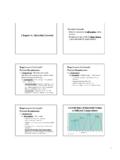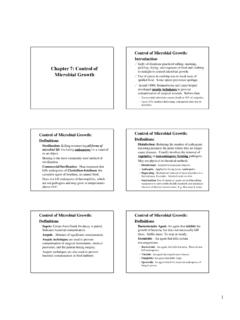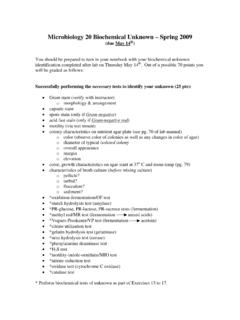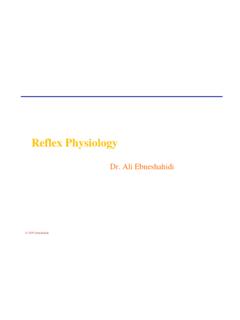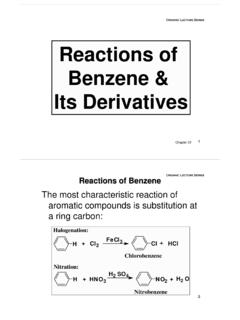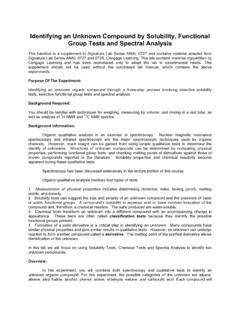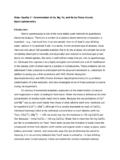Transcription of The Endocrine System - LA Mission
1 Copyright 2006 Pearson Education, Inc., publishing as Benjamin CummingsThe Endocrine SystemDr. Ali EbneshahidiCopyright 2006 Pearson Education, Inc., publishing as Benjamin CummingsEndocrine System The Endocrine System interacts with the nervous System to coordinate and integrate body activities by means of hormones. Endocrine tissues and organs secrete hormone into body fluids (mainly blood and lymph) directly using diffusion. Exocrine tissues, such as salivary glands, and sebaceous glands, secrete chemical substances through ducts into an open 2006 Pearson Education, Inc.
2 , publishing as Benjamin CummingsFive major functions of hormones a) Regulate metabolic processes ( thyroid hormones). b) Control the rate of chemical reactions ( growth hormone). c) Aid in the transport of substances across the cell membrane of target cells ( insulin and glucagon). d) Regulate water and electrolyte balances ( antidiurectic hormone, calcitonin, and aldosterone). e) Play a vital role in reproduction, growth and development ( estrogens , progesterone, and testosterone). Copyright 2006 Pearson Education, Inc.
3 , publishing as Benjamin CummingsMajor Endocrine OrgansCopyright 2006 Pearson Education, Inc., publishing as Benjamin CummingsChemistry of Hormones Hormones are organic compounds secreted by Endocrine glands, that have a potent effect in target cells Two types of hormones: a) Protein hormones: made of amino acids joined by peptide bonds. fat insoluble; as a result cannot diffuse across the membrane of target cells . most hormones belong to this group excepthormones secreted by the gonads (testis and ovary) and the adrenal cortex.
4 B) Steroid hormones: made of fatty acids using cholesterol as a functional group. Fat-soluble; as a result can diffuse into target cells . only hormones secreted by the gonads and adrenal cortex belong to this group . Copyright 2006 Pearson Education, Inc., publishing as Benjamin CummingsHormone Action 1. Most hormones adhere to the following action plan : a) Endocrine gland synthesizes the hormone . c) Hormone diffuses into capillaries . d) Hormone is transported by blood or lymph toward target cells . e) Hormone diffuses out of capillaries at target tissue, and causes an effect in target cells.
5 Copyright 2006 Pearson Education, Inc., publishing as Benjamin CummingsThyroid GlandCopyright 2006 Pearson Education, Inc., publishing as Benjamin Cummings 2. Each step of this action plan is highly specific and carefully controlled by the Endocrine and circulatory systems : synthesis of hormone using protein or lipid anabolism. secretion of hormone using exocytosis or diffusion . transport of hormone in the blood or lymph ( steroid hormones require a protein transporter during the transport). interaction between the hormone and target cell ( protein hormones require receptors at the cell membrane of target cells).
6 Copyright 2006 Pearson Education, Inc., publishing as Benjamin Cummings 3. Effects in the target cells caused by hormone action a. A change in cell membrane permeability ( insulin causes muscle cells to have a higher permeability for glucose). b. A change in chemical reaction rate ( growth hormone stimulates higher chemical reaction rates in muscle and bone cells). c. Enzyme activation ( epinephrine increases enzyme action in muscle cells). d. Activation of cell secretion ( melanocyte-stimulating hormone activates more melanin secretion from the melanocytes).
7 Copyright 2006 Pearson Education, Inc., publishing as Benjamin CummingsActions of steroid hormones 1. Steroid hormones bind to a protein transporter during the transport in blood of lymph . 2. When they have arrived at the target cells , the protein transporter (being fat-insoluble) is repelled by the cell membrane, while the steroid hormone (being fat-soluble) diffuses into the cytoplasm of target cell. 3. Steroid hormone also diffuses across the nuclear envelope and enters into the nucleus of target cell. 4. Steroid hormone binds to a specific receptor located on a particular gene of target cell s DNA.
8 5. This binding alters the genetic information within that gene, resulting in a new messenger RNA (mRNA) being produced after 2006 Pearson Education, Inc., publishing as Benjamin Cummings 6. this new mRNA sill be translated into a new protein (or enzyme) in the cytoplasm of target cell . 7. the new protein or enzyme causes a specific effect to occur within the target cells . Copyright 2006 Pearson Education, Inc., publishing as Benjamin CummingsSequence of steroid hormone action -Summary 1. Endocrine glands secrete steroid hormone.
9 2. Steroid hormone diffuses through target cell membrane . 3. Hormone combines with a receptor molecule . 4. steroid hormone-receptor complex binds to DNA and promotes synthesis of mRNA. 5. mRNA enters the cytoplasm and directs protein synthesis . 6. Newly synthesized protein produce hormone s specific effects. 7. The new protein causes a specific effect to occur within the target 2006 Pearson Education, Inc., publishing as Benjamin CummingsSteroid HormonesCopyright 2006 Pearson Education, Inc., publishing as Benjamin CummingsAction of protein hormones 1.
10 A protein hormone is transported in the blood or lymph by itself, without a transporter . 2. When it has arrived at the target cell, the protein hormone binds with a specific receptor embedded in the cell membrane of target cell. (The number of receptors changes in response to the amount of hormone released -- up-regulation refers to the phenomenon where more receptors will be produced to respond to a deficiency of the hormone; while down-regulation refers to the process of producing less receptors to respond to a large amount of hormone).
